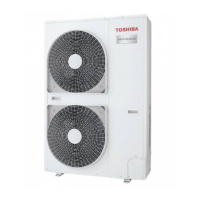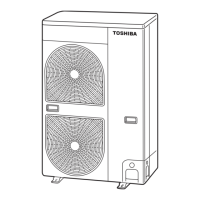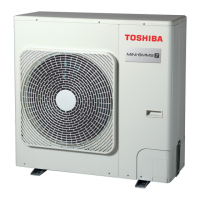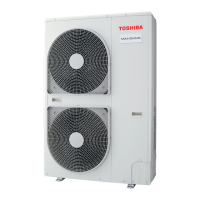What to do if my Toshiba MCY-MAP0804HT7 displays a TO sensor error?
- JJeff PerkinsSep 5, 2025
If your Toshiba Air Conditioner displays a TO sensor error, check TO sensor wiring.

What to do if my Toshiba MCY-MAP0804HT7 displays a TO sensor error?
If your Toshiba Air Conditioner displays a TO sensor error, check TO sensor wiring.
What to do if my Toshiba Air Conditioner displays a TL sensor error?
If your Toshiba Air Conditioner displays a TL sensor error, check TL sensor wiring.
Why is my Toshiba MCY-MAP0804HT7 Air Conditioner showing a phase missing or power failure detection error?
The Toshiba Air Conditioner indicates a phase missing or power failure detection error because of a power failure. Verify the power supply to the unit.
What to do if my Toshiba Air Conditioner displays a TD sensor error?
If your Toshiba Air Conditioner displays a TD sensor error, check TD sensor wiring.
What to do if my Toshiba Air Conditioner displays an inverter DC voltage error (on compressor)?
If your Toshiba Air Conditioner displays an inverter DC voltage error (on compressor), check the inverter DC voltage supply.
How do I troubleshoot a Toshiba MCY-MAP0804HT7 heat sink overheat error?
To troubleshoot a Toshiba Air Conditioner displaying a heat sink overheat error, inspect the heat sink for obstructions.
How do I fix a Toshiba Air Conditioner with an outdoor unit flow back error?
To fix a Toshiba Air Conditioner showing an outdoor unit flow back error, check flow direction and system settings.
What to do if my Toshiba MCY-MAP0804HT7 Air Conditioner displays an indoor overflow error?
If your Toshiba Air Conditioner displays an indoor overflow error, review the drainage system for blockages.
What to do if my Toshiba Air Conditioner displays a high-pressure protective operation error?
If your Toshiba Air Conditioner displays a high-pressure protective operation error, check system pressure settings.
What should I do if my Toshiba MCY-MAP0804HT7 Air Conditioner displays a low pressure protective operation error?
If your Toshiba Air Conditioner displays a low pressure protective operation error, check the system pressure levels.
| Brand | Toshiba |
|---|---|
| Model | MCY-MAP0804HT7 |
| Category | Air Conditioner |
| Language | English |
Details pertaining to the outdoor unit, including model names.
Lists the available language versions for the installation manual.
General safety instructions and warnings for installation personnel.
Criteria for choosing an appropriate installation site.
Safety measures to be observed during the installation work.
Safety advice related to handling refrigerant pipes.
Safety measures for electrical wiring installations.
Lists the owner's and installation manuals provided.
Details drain nipple and waterproof cap for water drainage.
Components like protective bush and guard material.
Joint pipes and sockets for internal pipe connections.
Lists tools and safety measures for R410A refrigerant.
Steps to prepare before starting the installation.
Method for conducting an airtightness test of the system.
Steps for removing air from the refrigerant lines.
Instructions for making electrical connections.
Importance and correct method for earthing the unit.
Steps to perform a test run after installation.
Critical warnings about unsuitable installation locations.
Conditions that make a location suitable for installation.
A list of locations where the unit must not be installed.
Specifies minimum clearances at the rear of the unit.
Specifies minimum clearances above the unit.
Specifies minimum clearances at the front of the unit.
Overhead clearances for units installed in series.
Clearance specifications for single unit setups.
Clearance specifications for multiple units installed in series.
Clearances for serial installations at front and rear.
Checking the base for stability and preventing noise.
Proper method for anchoring the unit's base.
Instructions on installing vibration-damping pads.
Considerations for foundation design with downward piping.
Attaching drain components for water discharge.
How to create openings in the pipe cover for pipes.
Step-by-step guide for making knockout holes.
Possible connection directions for indoor and outdoor pipes.
Installing protective bushes and guards for pipes/wires.
Advice for heating operations in freezing conditions.
List of optional piping and insulation materials.
List of optional putty and tape for sealing.
Important points to follow during piping installation.
Step-by-step guide for flaring refrigerant pipes.
Table detailing projection margins and flaring sizes.
Instructions for connecting pipes to the unit's front, sides, or back.
Instructions for connecting pipes when routed downwards.
Detailed steps for tightening flare nuts correctly.
Essential precautions for handling and tightening unit valves.
Table specifying coupling dimensions for brazed pipes.
Specifies the required material for refrigerant piping.
Guidelines for matching indoor and outdoor unit capacity codes.
Minimum wall thickness requirements for R410A piping.
Table correlating indoor unit capacity codes with HP equivalents.
Diagrams and tables for selecting appropriate pipe sizes.
Pipe size selection for connections between branching components.
Specifications for pipe sizes connecting to indoor units.
Model names for Y-shaped branching joints.
Model names for branching headers.
Model names for the PMV Kit.
Piping layout for quiet operation using a PMV Kit.
Pipe size specifications for outdoor unit connections.
Pipe sizing based on indoor unit capacity codes.
Pipe sizing for indoor units based on capacity.
Specifies maximum allowable lengths for various pipe sections.
Specifies maximum allowable height differences between units.
Maximum pipe lengths for systems using the PMV Kit.
Maximum height differences for systems using the PMV Kit.
Important note regarding PMV Kit connections to indoor units.
Detailed procedure for performing the airtight test.
Essential requirements and safety measures for the test.
Method for identifying large refrigerant leaks.
Method for identifying small refrigerant leaks.
Accounting for temperature-induced pressure changes during testing.
Emphasis on not releasing refrigerant into the atmosphere.
Procedure for removing air using a vacuum pump.
Requirements for the vacuum pump used in air purging.
How to operate the vacuum pump and verify system integrity.
Formula and method for calculating refrigerant to add.
Tables providing data for refrigerant charge calculations.
Correlating pipe lengths with indoor unit model codes.
Equation for calculating the extra refrigerant needed.
Step-by-step guide for charging refrigerant into the system.
How to correctly open and close unit valves.
Important safety and handling advice for valves.
Required torque for tightening valve caps.
Guidance on choosing the correct power wiring.
Requirements for communication wiring between units.
Summary of the communication wiring design.
Visual representation of the communication wiring setup.
Illustrates the wiring for group control systems.
Guidelines for control wire types and lengths.
Guidelines for remote controller wire types and lengths.
How to connect power supply and communication wires.
Note on keeping power and communication wires separate.
Steps for routing and connecting power wires to the unit.
Specifications for wire gauge and terminal screw torque.
Important cautions before proceeding with address setting.
Steps for automatically configuring unit addresses.
Steps for manually setting addresses using a remote controller.
How to configure the system address using DIP switches.
Specific instructions for setting the system address with switches.
How to disconnect relay connectors for central control setup.
How to connect relay connectors for central control setup.
Procedure for configuring the central control address.
Setting indoor unit addresses manually using a remote controller.
Diagram illustrating wiring for a two-line system.
Steps to pair indoor units and set addresses via remote controller.
How to check indoor unit addresses and their locations.
Procedure to modify the address of a specific indoor unit.
How to choose a system address to change.
Steps to update the indoor unit's address value.
Clearing individual addresses using a wired remote controller.
Clearing all addresses on a refrigerant line from the outdoor unit.
Clearing specific addresses using a remote controller.
Clearing all addresses on a refrigerant line from the outdoor unit.
Essential checks before performing a test run.
How to execute a test run with the remote controller.
Warning against using forcible running unnecessarily.
How to initiate an individual test run for a unit.
Configuring switches on the outdoor unit's PC board.
Procedure for using SW04 during test run operations.
Important points to observe during test runs.
Returning rotary switches to their default positions.
Resetting switches to stop the unit's operation.
How to begin a corrective test run.
Important considerations for corrective test runs.
Guide to understanding error codes shown on the display.
A table listing check codes and their meanings.
Explanations of auxiliary codes and associated problems.
Ensuring refrigerant concentration remains within safe limits.
Standards for minimum room volume to prevent suffocation risk.
Example calculation for refrigerant quantities in multi-room setups.
Relationship between floor area and refrigerant amount for safety.









